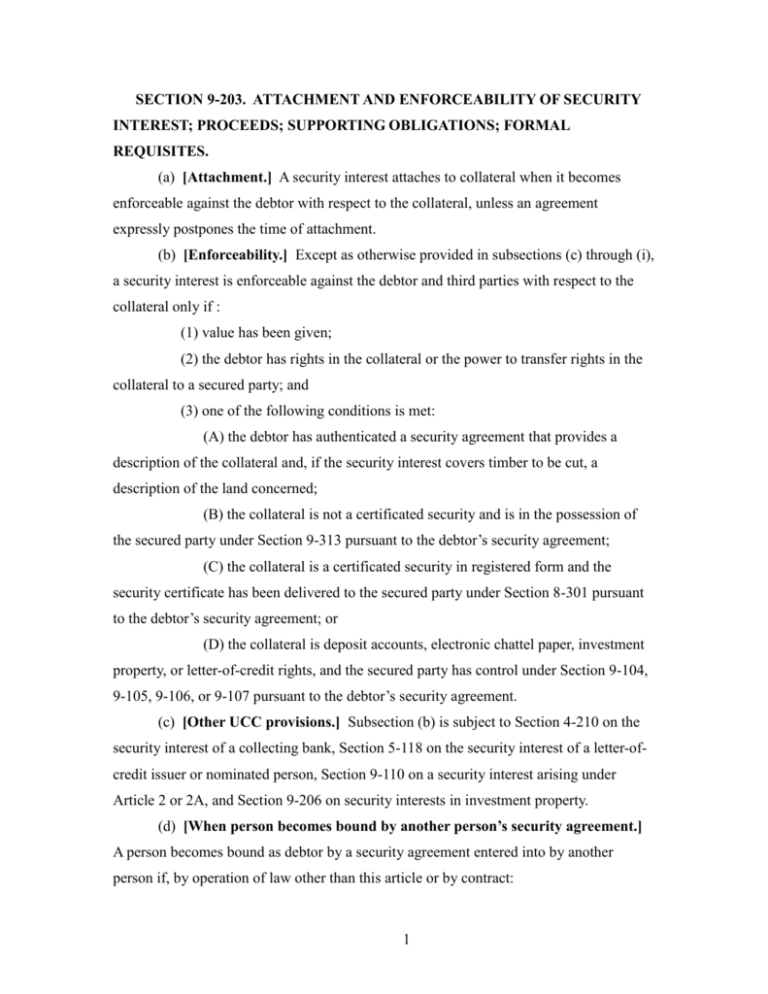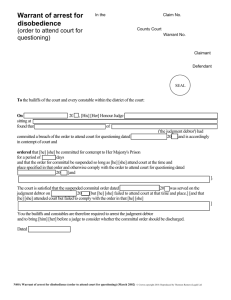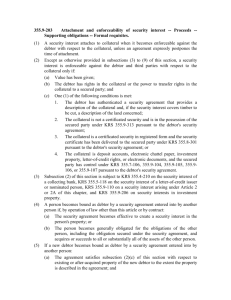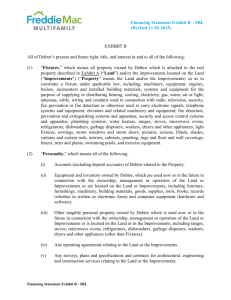
SECTION 9-203. ATTACHMENT AND ENFORCEABILITY OF SECURITY
INTEREST; PROCEEDS; SUPPORTING OBLIGATIONS; FORMAL
REQUISITES.
(a) [Attachment.] A security interest attaches to collateral when it becomes
enforceable against the debtor with respect to the collateral, unless an agreement
expressly postpones the time of attachment.
(b) [Enforceability.] Except as otherwise provided in subsections (c) through (i),
a security interest is enforceable against the debtor and third parties with respect to the
collateral only if :
(1) value has been given;
(2) the debtor has rights in the collateral or the power to transfer rights in the
collateral to a secured party; and
(3) one of the following conditions is met:
(A) the debtor has authenticated a security agreement that provides a
description of the collateral and, if the security interest covers timber to be cut, a
description of the land concerned;
(B) the collateral is not a certificated security and is in the possession of
the secured party under Section 9-313 pursuant to the debtor’s security agreement;
(C) the collateral is a certificated security in registered form and the
security certificate has been delivered to the secured party under Section 8-301 pursuant
to the debtor’s security agreement; or
(D) the collateral is deposit accounts, electronic chattel paper, investment
property, or letter-of-credit rights, and the secured party has control under Section 9-104,
9-105, 9-106, or 9-107 pursuant to the debtor’s security agreement.
(c) [Other UCC provisions.] Subsection (b) is subject to Section 4-210 on the
security interest of a collecting bank, Section 5-118 on the security interest of a letter-ofcredit issuer or nominated person, Section 9-110 on a security interest arising under
Article 2 or 2A, and Section 9-206 on security interests in investment property.
(d) [When person becomes bound by another person’s security agreement.]
A person becomes bound as debtor by a security agreement entered into by another
person if, by operation of law other than this article or by contract:
1
(1) the security agreement becomes effective to create a security interest in the
person’s property; or
(2) the person becomes generally obligated for the obligations of the other
person, including the obligation secured under the security agreement, and acquires or
succeeds to all or substantially all of the assets of the other person.
(e) [Effect of new debtor becoming bound.] If a new debtor becomes bound as
debtor by a security agreement entered into by another person:
(1) the agreement satisfies subsection (b)(3) with respect to existing or afteracquired property of the new debtor to the extent the property is described in the
agreement; and
(2) another agreement is not necessary to make a security interest in the
property enforceable.
(f) [Proceeds and supporting obligations.] The attachment of a security interest
in collateral gives the secured party the rights to proceeds provided by Section 9-315 and
is also attachment of a security interest in a supporting obligation for the collateral.
(g) [Lien securing right to payment.] The attachment of a security interest in a
right to payment or performance secured by a security interest or other lien on personal or
real property is also attachment of a security interest in the security interest, mortgage, or
other lien.
(h) [Security entitlement carried in securities account.] The attachment of a
security interest in a securities account is also attachment of a security interest in the
security entitlements carried in the securities account.
(i) [Commodity contracts carried in commodity account.] The attachment of
a security interest in a commodity account is also attachment of a security interest in the
commodity contracts carried in the commodity account.
Official Comment
1. Source. Former Sections 9-203, 9-115(2), (6).
2. Creation, Attachment, and Enforceability. Subsection (a) states the general
rule that a security interest attaches to collateral only when it becomes enforceable
against the debtor. Subsection (b) specifies the circumstances under which a security
interest becomes enforceable. Subsection (b) states three basic prerequisites to the
existence of a security interest: value (paragraph (1)), rights or power to transfer rights in
2
collateral (paragraph (2)), and agreement plus satisfaction of an evidentiary
requirement (paragraph (3)). When all of these elements exist, a security interest
becomes enforceable between the parties and attaches under subsection (a). Subsection
(c) identifies certain exceptions to the general rule of subsection (b).
3. Security Agreement; Authentication. Under subsection (b)(3), enforceability
requires the debtor’s security agreement and compliance with an evidentiary requirement
in the nature of a Statute of Frauds. Paragraph (3)(A) represents the most basic of the
evidentiary alternatives, under which the debtor must authenticate a security agreement
that provides a description of the collateral. Under Section 9-102, a “security agreement”
is “an agreement that creates or provides for a security interest.” Neither that definition
nor the requirement of paragraph (3)(A) rejects the deeply rooted doctrine that a bill of
sale, although absolute in form, may be shown in fact to have been given as security.
Under this Article, as under prior law, a debtor may show by parol evidence that a
transfer purporting to be absolute was in fact for security. Similarly, a self-styled “lease”
may serve as a security agreement if the agreement creates a security interest. See
Section 1-201(37) (distinguishing security interest from lease).
4. Possession, Delivery, or Control Pursuant to Security Agreement. The
other alternatives in subsection (b)(3) dispense with the requirement of an authenticated
security agreement and provide alternative evidentiary tests. Under paragraph (3)(B), the
secured party’s possession substitutes for the debtor’s authentication under paragraph
(3)(A) if the secured party’s possession is “pursuant to the debtor’s security agreement.”
That phrase refers to the debtor’s agreement to the secured party’s possession for the
purpose of creating a security interest. The phrase should not be confused with the
phrase “debtor has authenticated a security agreement,” used in paragraph (3)(A), which
contemplates the debtor’s authentication of a record. In the unlikely event that
possession is obtained without the debtor’s agreement, possession would not suffice as a
substitute for an authenticated security agreement. However, once the security interest
has become enforceable and has attached, it is not impaired by the fact that the secured
party’s possession is maintained without the agreement of a subsequent debtor (e.g., a
transferee). Possession as contemplated by Section 9-313 is possession for purposes of
subsection (b)(3)(B), even though it may not constitute possession “pursuant to the
debtor’s agreement” and consequently might not serve as a substitute for an authenticated
security agreement under subsection (b)(3)(A). Subsection (b)(3)(C) provides that
delivery of a certificated security to the secured party under Section 8-301 pursuant to the
debtor’s security agreement is sufficient as a substitute for an authenticated security
agreement. Similarly, under subsection (b)(3)(D), control of investment property, a
deposit account, electronic chattel paper, or a letter-of-credit right satisfies the evidentiary
test if control is pursuant to the debtor’s security agreement.
5. Collateral Covered by Other Statute or Treaty. One evidentiary purpose of
the formal requisites stated in subsection (b) is to minimize the possibility of future
disputes as to the terms of a security agreement (e.g., as to the property that stands as
collateral for the obligation secured). One should distinguish the evidentiary functions of
the formal requisites of attachment and enforceability (such as the requirement that a
3
security agreement contain a description of the collateral) from the more limited goals of
“notice filing” for financing statements under Part 5, explained in Section 9-502,
Comment 2. When perfection is achieved by compliance with the requirements of a
statute or treaty described in Section 9-311(a), such as a federal recording act or a
certificate-of-title statute, the manner of describing the collateral in a registry imposed by
the statute or treaty may or may not be adequate for purposes of this section and Section
9-108. However, the description contained in the security agreement, not the description
in a public registry or on a certificate of title, controls for purposes of this section.
6. Debtor’s Rights; Debtor’s Power to Transfer Rights. Subsection (b)(2)
conditions attachment on the debtor’s having “rights in the collateral or the power to
transfer rights in the collateral to a secured party.” A debtor’s limited rights in collateral,
short of full ownership, are sufficient for a security interest to attach. However, in
accordance with basic personal property conveyancing principles, the baseline rule is that
a security interest attaches only to whatever rights a debtor may have, broad or limited as
those rights may be.
Certain exceptions to the baseline rule enable a debtor to transfer, and a security
interest to attach to, greater rights than the debtor has. See Part 3, Subpart 3 (priority
rules). The phrase, “or the power to transfer rights in the collateral to a secured party,”
accommodates those exceptions. In some cases, a debtor may have power to transfer
another person’s rights only to a class of transferees that excludes secured parties. See,
e.g., Section 2-403(2) (giving certain merchants power to transfer an entruster’s rights to
a buyer in ordinary course of business). Under those circumstances, the debtor would not
have the power to create a security interest in the other person’s rights, and the condition
in subsection (b)(2) would not be satisfied.
7. New Debtors. Subsection (e) makes clear that the enforceability requirements
of subsection (b)(3) are met when a new debtor becomes bound under an original
debtor’s security agreement. If a new debtor becomes bound as debtor by a security
agreement entered into by another person, the security agreement satisfies the
requirement of subsection (b)(3) as to the existing and after-acquired property of the new
debtor to the extent the property is described in the agreement.
Subsection (d) explains when a new debtor becomes bound. Persons who become
bound under paragraph (2) are limited to those who both become primarily liable for the
original debtor’s obligations and succeed to (or acquire) its assets. Thus, the paragraph
excludes sureties and other secondary obligors as well as persons who become obligated
through veil piercing and other non-successorship doctrines. In many cases, paragraph
(2) will exclude successors to the assets and liabilities of a division of a debtor. See also
Section 9-508, Comment 3.
8. Supporting Obligations. Under subsection (f), a security interest in a
“supporting obligation” (defined in Section 9-102) automatically follows from a security
interest in the underlying, supported collateral. This result was implicit under former
Article 9. Implicit in subsection (f) is the principle that the secured party’s interest in a
4
supporting obligation extends to the supporting obligation only to the extent that it
supports the collateral in which the secured party has a security interest. Complex issues
may arise, however, if a supporting obligation supports many separate obligations of a
particular account debtor and if the supported obligations are separately assigned as
security to several secured parties. The problems may be exacerbated if a supporting
obligation is limited to an aggregate amount that is less than the aggregate amount of the
obligations it supports. This Article does not contain provisions dealing with competing
claims to a limited supporting obligation. As under former Article 9, the law of
suretyship and the agreements of the parties will control.
9. Collateral Follows Right to Payment or Performance. Subsection (g)
codifies the common-law rule that a transfer of an obligation secured by a security
interest or other lien on personal or real property also transfers the security interest or
lien. See Restatement (3d), Property (Mortgages) § 5.4(a) (1997). See also Section
9-308(e) (analogous rule for perfection).
10. Investment Property. Subsections (h) and (i) make clear that attachment of a
security interest in a securities account or commodity account is also attachment
in security entitlements or commodity contracts carried in the accounts.
© by ALI and NCCUSL. Reproduced with the permission of the PEB for the
UCC. All rights reserved.
5





